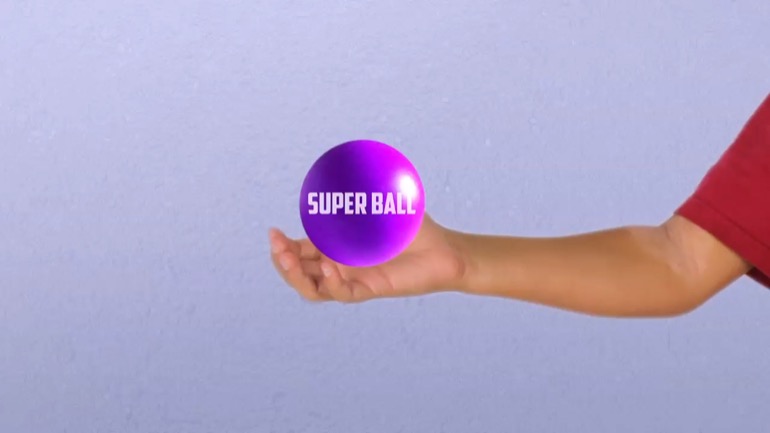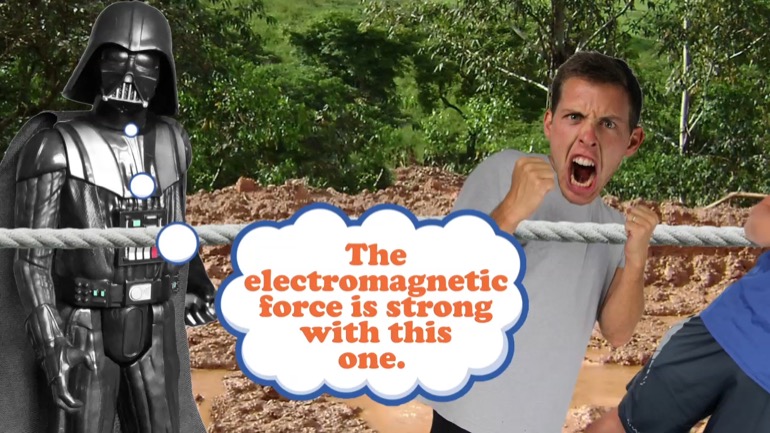ShmoopTube
Where Monty Python meets your 10th grade teacher.
Search Thousands of Shmoop Videos
Physics Videos 34 videos
Isaac Newton. Who was he? Why do we need to know about him? In a physics course, no less? Well, he's only the most famous physicist in history, and...
What are the basics of trigonometry? And why are we learning about this in a physics course? Both good questions. In this video, you'll learn about...
It's time to make our liters and meters work together. Enough of the bickering, right? In this video, we'll do some unit analysis, covering SI Unit...
Physics: Projectile Prediction: Galileo, Trigonometry, and an Experiment 16 Views
Share It!
Description:
It's experiment time. We'll be rolling a marble down a ramp... and we'll see what it tells us about gravity, acceleration, and velocity.
Transcript
- 00:00
Shmoop! Projectile Prediction: Galileo, trigonometry, and an experiment.
- 00:09
[mumbling]
- 00:18
[mumbling]
- 00:31
So, a long time ago there was this guy named, Galileo Galilei and his parents
- 00:38
were cruel. He was a super-smart Italian guy, who figured out a way to measure
Full Transcript
- 00:42
gravity. Now that may not sound too impressive today, but he did all this
- 00:46
science, in the 1500s. He didn't have any fancy computers, or a smart phone to [Galileo in different rooms experimenting]
- 00:52
record stuff, or YouTube to watch videos of dogs and monkeys being best friends.
- 00:56
Nope, he had to figure out a simple way to measure gravity. So what he did was
- 01:01
set up a ramp, roll the ball down it and timed how long it took. And he did this
- 01:06
experiment hundreds of times. Because again no YouTube, what else was he going
- 01:10
to do all day. What did he find? Well for one thing, he found that each time he did
- 01:15
the experiment, when the ball was halfway through the trip, in terms of time. It was
- 01:20
only one quarter of the way through it, in terms of distance. So the ball covered [Galileo rolling experiment]
- 01:25
three quarters of the distance, in the last half of the roll. He also learned
- 01:29
that the angle of the incline, directly correlated with the speed of the ball at
- 01:34
the bottom of the ramp. In fact the acceleration equalled the
- 01:37
force of gravity, times the sine of the angle of inclination.
- 01:42
Oh yeah, consider this a warning, in this lesson we'll be getting our trigonometry
- 01:46
on. Galileo also found that the ball, would continue to travel horizontally, at
- 01:51
the same speed, as when it left the ramp and that speed would stay constant until
- 01:56
something stopped it. Like hitting a wall, or falling on the Galileo's foot. Well
- 02:02
we're gonna be doing an experiment of our own, in just a minute, that's kind of [atom talking]
- 02:05
similar. But let's make sure we're clear on the math, first. In our other lessons
- 02:09
we've used the acceleration of gravity, as 9.8 meters per second, squared, as our
- 02:16
only form of acceleration. However since we'll be dealing with an
- 02:19
incline, we can't use gravity, because we're not dealing with freefall anymore.
- 02:24
So the first thing we have to do, is to calculate the correct acceleration, using [atom talking]
- 02:28
that equation, we just mentioned. This one rod chair. Well once we have that
- 02:32
acceleration, we're able to find the final velocity.
- 02:36
Remember this equation, that one. It tells us that the square, of the final velocity,
- 02:40
equals the square, of the initial velocity, plus two times the acceleration,
- 02:44
times the change in displacement. In this case the change in displacement will be
- 02:50
the length of the ramp. Oh and all of this motion is in the horizontal [ramp with equations]
- 02:54
direction. Which is why we've got all these X's. Once we have that final
- 02:57
velocity, it becomes the speed of the ball as it leaves the ramp and then? Well
- 03:02
then we can predict the future. Not at tomorrow's winning lottery numbers kind
- 03:06
of prediction. More of a here's where a marble will land, when it rolls off the
- 03:10
table, kind of prediction. Okay well let's get our lab set up. First we need
- 03:14
equipment. We need some small dense ball like a marble, or maybe something metal.
- 03:18
As long as it's not bouncy, we should be just fine. Next up, a table and we mean an
- 03:23
actual table this time, not a data table. Some kind of smooth surface that we can [ball rolling on table]
- 03:27
roll the ball off of. Yep it could be a counter top, or the top of the dresser.
- 03:31
Next up a measuring tape, or a ruler, or a meter stick. Well we want to be using
- 03:37
metric measurements, but a worse comes to worse, we can always convert. And
- 03:40
if you're making a conversion, just know, that one inch equals 2.54 centimeters.
- 03:45
Then we need something to make our ramp. Now if you already have some sort of
- 03:49
ramp like thing, like maybe an old triangular wooden block you used to play
- 03:53
with, or a piece of Hot Wheels track, well then feel free to use that. We're [man being snob in empty room]
- 03:57
not gonna be ramps snobs. Just make sure that angle isn't too steep. Nothing more
- 04:01
than 30 degrees. Otherwise see if you have some heavy cardstock, or some
- 04:06
lightweight cardboard, something like that. We can DIY our own ramp out of that
- 04:10
stuff, and pen, paper, scissors and tape. Oh and also we might want to use a plumb
- 04:14
bob and no it's not a guy named Bob, who can unclog your bathtub. A plumb bob is a
- 04:20
weight, that hangs straight down from a string. This weight will let us find exactly
- 04:25
where the edge of the table is on the ground. We just hang our plumb bob from[atom doing experiment]
- 04:28
the end of the table, like this. It takes some guesswork out of determining where
- 04:32
the freefall will start. And last, but never least, we need a calculator. An
- 04:36
actual calculator, a calculator app, something on a webpage, whatever, okay. Now
- 04:42
we need to put everything together. Make sure the table is level, set your marble
- 04:46
down and see if it rolls to one side, or another.
- 04:49
If it does, put some paper, or something under one of the tables legs. Help set it
- 04:52
straight. If you need to make your own ramp from the cardstock, or cardboard,
- 04:55
well and go ahead and do that now. We're gonna leave this feat of engineering to
- 04:58
you though, all on your own. Just figure out some way to make a stiff ramp, that's
- 05:01
pretty shallow. This isn't a scary waterslide we're building, we want just a[man on resort water slide]
- 05:05
fairly gentle roll. So here's the plan we're gonna set up our ramp at one end
- 05:10
of the table. We'll let the ball roll down it. Then on the other side, when the
- 05:13
ball falls off the table. We're gonna mark where we think it will land. So how
- 05:18
do we figure out that landing spot? Well first it might help to draw a little
- 05:21
diagram of what we're working with. The ramp, the table and the floor for
- 05:25
starters. Then measure the length and height of the table, go ahead and write
- 05:28
those measurements down on the diagram and we need to measure the ramp to, the
- 05:32
length, height and hypotenuse. And yeah write those measurements down, we don't [measurements of experiment]
- 05:36
want to forget them. While we're doing all these measurements, figure out how
- 05:39
tall you are. Has nothing to do with the experiment, it's just you know good to
- 05:43
keep track. All right well with the measurements of the ramp, we can
- 05:45
calculate the angle of the incline. Remember sohcahtoa, no it's not an
- 05:50
ancient druid chant. It's a way to remember trig functions. We'll just look
- 05:54
at the SOH part. That tells us that the sign of an angle, equals the opposite [equations on chalkboard]
- 06:00
side, over the hypotenuse. Which would be helpful if we knew the angle already and
- 06:05
knew the length of one of the sides. Yeah, then we could find the length of
- 06:09
whichever side we didn't know. Well in this case we know the length of both
- 06:12
sides. We don't know the angle, which means we need to break out the inverse
- 06:16
function of sign. Well ladies and gentlemen, please welcome back to the
- 06:20
stage, the arc sign. Ya, the arc sign is kind of the opposite of the sign. So if
- 06:25
sign x, equals y, arc sign y, equals x. Now make sure your calculator is set for [calculator preforming functions]
- 06:31
degrees and for the inverse of functions. Then find the arc sign of the length, of
- 06:36
the opposite side, divided by the length of the hypotenuse. Because we know
- 06:40
the lengths of each side, we can use any of the inverse functions, arc cosine, arc
- 06:45
tangent, pick your poison. And slap that number up on the diagram too. Okay almost
- 06:50
time to look into our crystal ball. But we have to calculate our velocity first.
- 06:55
Step one, acceleration. Which equals gravity times, the sign of the angle of [formulas on chalkboard]
- 07:00
incline. The gravity is always, 9.8 m/s^2 because, we're on earth. Let's
- 07:06
say that we happen to have, a perfect 30-degree angle of incline. When we put
- 07:12
that number in, we find that our acceleration equals 4.9 m/s squared. And
- 07:17
then we need that final velocity. First let's figure out the horizontal velocity.
- 07:21
The square of the final velocity, will equal the square of the initial velocity,
- 07:26
plus 2 times the acceleration, times the change in displacement. Our initial [atom talking and chalkboard equations]
- 07:32
velocity will be 0. So that makes things a little easier and let's say the ramp
- 07:36
is 20 centimeters long. We want our velocity to be in terms of meters per
- 07:41
second though, so we'll call it 0.2 meters. So we double our acceleration,
- 07:46
making that 9.8 meters per second squared and we multiply that
- 07:50
acceleration by, 0.2 meters. Which means that the square of the final velocity
- 07:54
equals 1.96 meters per second. And when we find that square root, to solve for [formulas on chalkboard]
- 08:00
the velocity. We get 1.4 meters per second. Well now we have to figure out
- 08:05
how long it'll take this ball, to fall to the ground, after it rolls off the table.
- 08:08
Which means it's time for another equation. We're sure you remember which
- 08:12
one to use. Which is good because we don't. Oh yeah, now it's coming back to us.
- 08:16
We'll use this one, the final displacement, equals the initial
- 08:20
displacement, plus the initial velocity, times the elapsed time, plus 1/2
- 08:25
acceleration, times the square of the time. Our final displacement will be, the [equations on chalkboard]
- 08:30
height of the table and our initial displacement will be, 0. Our initial
- 08:34
velocity will be 0, just standing there, because you know, right now we're just
- 08:37
looking at this vertical velocity. Forget about all that horizontal junk, we were
- 08:41
looking at before. Well don't actually forget it, we'll need it in a minute. With
- 08:45
those two values, equaling zero, we're left with this, the height of the table,
- 08:49
equals 1/2 the acceleration. In this case gravity, times the square of the time and
- 08:55
that time, is what we need to solve for. Time to rearrange the furniture, in this [atom talking in classroom]
- 08:59
equation. Well we'll start by multiplying both sides by 2, then we'll divide both
- 09:04
sides by the acceleration and don't forget to find the square root of each
- 09:07
side also, so we can get all the way down to plane
- 09:11
T. So the square root of two times the displacement, divided by the acceleration,
- 09:15
equals the time. If we say that the table is one meter tall and plug in the
- 09:19
numbers, we'd find that the time equals 0.45 seconds. A little longer than the
- 09:25
blink of an eye. So keep those eyes peeled, we don't want to miss anything. [atom talking with red background]
- 09:28
All right now we're ready to make a prediction. We have our horizontal
- 09:31
velocity and we know how long the ball will be in flight. Multiply those two
- 09:36
numbers and we'll have the horizontal distance, aka the range. Go ahead and
- 09:40
write that value down as the predicted distance. And measure out that distance
- 09:44
from the edge of the table, putting that plumb bob to use, if necessary. Now tape
- 09:48
your paper down, so it's centered. You know, where you expect the ball to land.
- 09:52
Go ahead and draw a line across the paper, of that predicted distance, good.[atom setting up experiment]
- 09:56
Experiment assembly is officially complete, time to get the ball rolling. Go
- 10:00
ahead and place your marble at the top of the ramp and let that bad boy get
- 10:03
going and hustle over to see where it lands. Make an X, at that landing spot.
- 10:08
Then measure the shortest distance from that spot, to the line we drew earlier.
- 10:11
That distance, if there is one, is our experimental error. Feel free to run the
- 10:17
experiment a few more times. Go ahead, don't be shy, more data is always good.
- 10:21
Besides it took a lot to set all this stuff up, so like let's amortize it, a [atom talking with blue background]
- 10:26
little bit people. All right, yeah. Okay, all done? Did we get it right? If not
- 10:30
well and we had some experimental error. Well what what might have gone wrong? Was
- 10:34
the table not as level as we thought? Did the ball hit a stray cheerio as it
- 10:39
rolled? Did our sister start talking, creating a sudden gust of wind, that blew
- 10:44
the marble off course. And what was our actual horizontal velocity? We can
- 10:48
calculate that vector, by finding our actual change in horizontal displacement
- 10:51
and the time, to figure out how fast the ball was going when it fell off the
- 10:56
table. And how about this question, which would be more accurate? Calculating the [atom running experiment]
- 11:01
expected time the ball takes to fall to the floor, or using a stopwatch to
- 11:05
measure it. Well thanks to our good buddy Galileo, or the big double G, as we like to call
- 11:10
him. We know just how strong gravity is. Without that knowledge, we wouldn't have
- 11:15
been able to do this experiment at all. Now some of Galileo's later work got him
- 11:19
in trouble. In fact his insistence that the earth isn't the center of the
- 11:24
universe, got him placed under house arrest by the Catholic Church. But I
- 11:28
promise, stick with me and the Spanish Inquisition won't come knockin at your
- 11:32
door.[Galileo wondering halls]
Related Videos
When you're about to marry the love of your life, not many things could stop you. However, finding out that your future hubby is keeping his crazy...
Here at Shmoop, we work for kids, not just the bottom line. Founded by David Siminoff and his wife Ellen Siminoff, Shmoop was originally conceived...
ACT Math: Elementary Algebra Drill 4, Problem 5. What is the solution to the problem shown?
AP® English Literature and Composition Passage Drill 1, Problem 1. Which literary device is used in lines 31 to 37?
AP® English Literature and Composition Passage Drill 2, Problem 1. What claim does Bacon make that contradicts the maxim "Whatsoever is delig...






































